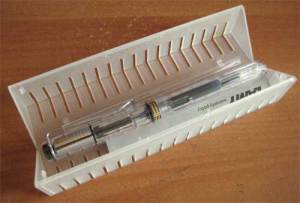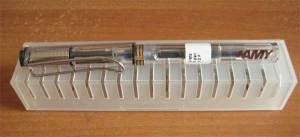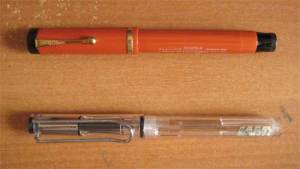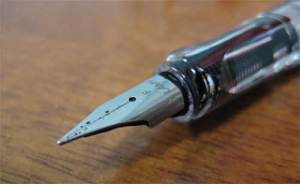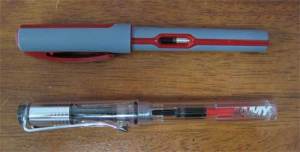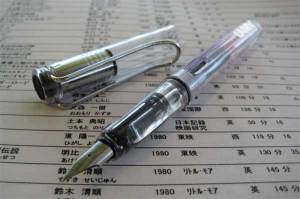JetPens graciously sent me a Lamy Vista. In addition to stocking this excellent pen, JetPens also provides a whole range of Japanese pens at reasonable prices, with prompt service.
What’s a Lamy Vista?
When Manfred Lamy took over the company from his father, he decided to focus on creating original pens that would fuse utility with original design elements. This tradition continues with the Noto designed by Fukasawa Naoto.
The Vista is simply a clear version of the Lamy Safari. The Lamy Safari, designed by Wolfgang Fabian, was first released in 1980 as a school pen targeted at the youth market. Following Manfred Lamy’s direction, the Safari has many design features that anticipate its intended uses. Since its first production run the Safari has endured, gaining a reputation for reliability, aesthetic simplicity and smooth writing in an inexpensive package.
Packaging
The Vista comes in a translucent plastic box with slits down the length – a bit like a piano keyboard. The translucent plastic is unique to the Vista.
(On a side note, regular Safari models used to be packaged in a distinctive unfinished dark grey paper version of this box. Lamy has since reduced this to a blister pack and a PVC pouch. Ah well.)
The slits seem to tantalize the viewer, providing glimpses of the pen but not its entirety. For the Vista, the translucent plastic complements the clear pen inside while signaling that it’s a bit more expensive than regular Safari models.
On to the pen!
The Pen!
The Safari was designed primarily for the student market, so it’s meant to look attractive while being rugged, practical and cheap.
Lots of reviews have already pointed out that its ruggedness. The ABS plastic construction feels solid (for a plastic pen), even if the pen on the whole is a bit light. The Vista is no different.
(If you prefer metal, there’s an aluminium variant of the Safari – the Al-Star.)
The paperclip-like chromed clip grips tightly to almost any pocket, especially jeans and bag pockets (again, designed with young people in mind). The clip – chromed on the Vista but enameled on some Safari models – won’t scratch or tear the fabric.
The barrel has two flat surfaces that run down its length. Some point out that this helps prevent the pen from rolling off a flat surface, but the barrel’s still round enough that the pen does roll easily even on very slight inclines. So keep that Safari / Vista / Al-Star capped or posted when you put it down.
Speaking of which – posting the cap is not a problem.
The Vista, is sometimes called a demonstrator version, though this isn’t really accurate. Demonstrators are clear versions of a pen that salespeople use to show customers the inner workings of the pen. However, the Vista is its own product line. Besides, there was a Safari demonstrator in the 1980s. Unlike the Vista the demonstrator has a black inner cap and no hotstamped foil-like logo at the end of the barrel.
But what I really liked was how, even with all the above, the overall design evoked the shape and feel of classic pens such as the Parker Duofold and the Sheaffer Flattop.
The grip has two flat inclines that automatically align your hand and the pen for writing. This is probably helpful for most people, but left-handers and some with unusual writing positions may not like this.
Enough ogling – time to see how it performs.
Performance
I generally don’t like blue ink, and I didn’t want to write with the blue ink cartridge that came with the pen.
So I got a converter – the Z24 model (but anecdotes suggest the Z26 works too). Looking at the pen again, I like the accent that the red on the converter adds.
Next I flushed the pen with water. This is standard practice for me as Lamy tests all their pens with a bit of blue ink before shipping them out.
Then I filled the Vista with some J. Herbin Poussiere de Lune.
The pen writes smoothly. The nib is rigid, but this is expected from steel nibs. Lamy steel nibs do have a little bit of flex to them, so it’s not quite a nail.
I haven’t been able to confirm this yet, but other reviews and online anecdotes also suggest that the Safari/Vista won’t skip when writing even if it hasn’t been uncapped in weeks, laying down ink the moment nib touches paper.
Swapping nibs
I’m most impressed by how the feed and nib are designed to allow you to easily swap nibs.
With most pens you need to replace the entire nib section. With the Vista/Safari all you need to do is pull the nib out and push its replacement in. Dead simple.
Just to try for myself I pulled the nib out and put it back in, following the easy instructions here. Just a tip: don’t worry too much about springing the nib. Use your forefinger under the tines to exert a bit more pressure upwards while pulling the nib out.
(On a side note, I’ve actually seen a pen shop employee pull out and push in Lamy steel nibs on a Safari using pliers. I was aghast at first, despite knowing he was experienced and probably knew what he was doing. Sure enough the nib wasn’t bent and the Safari worked fine. But I wouldn’t try that myself.)
Moreover the steel nibs are inexpensive and easily available, online at the least. So it’s easy to build a collection of different nibs (haven’t you seen the italic ones?) without breaking the bank.
More practically, it also means that you don’t have to worry about spending lots of money for a new nib. Vista landed on the floor nib down? Just swap it out. Scored a cheap Safari with a busted nib at a garage sale? Just clean the pen out, swap the nib and it’s ready to write again.
In addition, Lamy has adopted this swappable nib/feed system in their other pens. So if you upgrade to a Studio or an Accent, you don’t have to throw your Lamy nibs out.
Overall
The Safari is clearly designed to appeal to young people, but it’s a great pen for anyone who’s just starting to learn the basics of using a fountain pen regardless of age.
There’re other school pens out there as well, in the same price range as the Safari / Vista. Three of the most commonly suggested alternatives are the Waterman Phileas / Kultur, the Pelikan Pelikano and the Parker 45.
While everyone naturally has their own favorites, I’d like to suggest that the Safari is superior for the following reasons:
— the Safari has a wider girth and feels more substantial in the hand than either the Pelikano or the Parker 45 (I tried a Parker 45 once and it felt like using a pencil).
— the easy availability of a wide range of inexpensive nibs that perform well. You can’t swap the nib on a Phileas. You can swap nibs on a Pelikano, but finding individual nibs is difficult. Parker 45s have a clever nib assembly that unscrews but replacements are expensive and harder to find now that the 45 is out of production.
— The Safari has a long history of its own. The Parker 45 may have been the first cartridge pen produced, but the Safari has been in production for over 20 years, with the same design that recalls classic pens of the 1930s such as the Parker Duofold and the Sheaffer Flattop (there have been only internal design tweaks). The Pelikano keeps getting redesigned, and the Parker 45 has seen some reinventions since its introduction.
— As they say – imitation is the sincerest form of flattery 😉
And if you, like me, think that a transparent pen is simply cool:
— The Vista – a transparent Safari – just costs a little more than regular Safari. There isn’t a transparent Pelikano, and Parker 45 demonstrators are collectors’ items. The Waterman Kultur is a transparent Phileas, but that pen doesn’t have all the thoughtful, well-executed design features of the Safari/Vista.
So if you’re looking for an inexpensive, reliable writer that will survive many knocks and still look good (it was awarded the iF International Forum Design Award in Hannover in 1994), there’s most likely a Safari, a Vista or an Al-Star for you.
Find the Lamy Safari, Vista, Al-Star and more! – at JetPens
